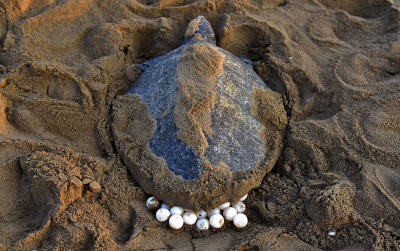The authors knew that the seals have hunted penguins before because it was done in an efficient, effective manner, and it did not look as though it was the seals first time at hunting penguins. They observed that after the catch, the seals would shake the penguin, ripping chunks of flesh, skin, and feathers off, swallowing the chunks. The authors observed a seal eating a carcass, but could not ascertain whether or not the seal killed or scavenged it. The authors also observed various sea birds taking advantage of the seals expertise in acquiring a penguin, and one bird (a Giant Petrel) actually “stole” a penguin carcass from a fur seal. The bird and the seal both had a carcass and were observed to be eating the flesh or stomach contents of the bird. It is possible that these hunting events occur wherever the penguins and fur seals ranges overlap.
 |
| Figure 1. A subadult male fur seal grasping a fledgling Adelie penguin (Photo by INV) |
The two types of penguins and the fur seals are all common species in the Antarctic, and they overlap quite profusely. It is unknown how or why the fur seals hunt the penguins. It is possible that they learned their technique from Giant Petrels or other species of seals, such as the Leopard Seal which is known to regularly hunt penguins. The authors think it is possible that the seals supplement their typical diet with penguins in an opportunistic manner. They also think that penguin predation is a more regular occurrence than previously recognized due to the high amount of penguin feathers in seal scat.
When examining the scat of many different seals from several different islands, it was found that the seals diet was predominately penguin with some krill (due to the pink coloration). Species of penguin was undetermined. The high amount of predation is thought to be near the end of the season when fledgling chick’s numbers are high and adults are returning from hunting, thus having a full stomach. This may suggest that penguins are actually an important part of the seals diet, and not just an opportunistic meal. If the fledglings are targeted only in an opportunistic manner, long term effects will be minimal. However, if they are targeting adult penguins, the effect will hit both the adults and the chicks, decreasing populations sizes overall. This could affect penguin ecology in general.
Although this entire paper was based off of a few observations of fur seals preying on penguins thus making it partially biased, it may also indicate an increase in fur seal predation on penguins that are seasonally abundant, and this could cause a long-term decline in penguin numbers if the seals and their preying ways continue to increase. This paper was designed in the hopes of encouraging other naturalists to document observations such as these. It would be of great value for scientists to conduct systematic observations at different locations to determine the scope of this predation in its entirety.
References
Orca Research Trust - Scientific Articles



























